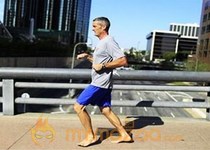Whether you're interested in running a marathon or staving off the chronic diseases of ageing, to reap the rewards of your efforts getting into the zone is essential.
Experts say knowing and staying within your heart rate training zone is an easy way to pace the intensity of your workout.
"Exercisers need to get to at least a moderate level of physical activity in order to reap the benefits," said Dr. Adrian Hutber of the American College of Sports Medicine. "Your goal is to get to a stage where you're fit enough to exercise within your heart rate training zone."
Your heart rate training zone, or target heart rate, is based on your maximum heart rate (MHR), which is roughly calculated as 220 minus your age.
"It's not exact but it doesn't need to be," said Hutber. "It's a really good indicator."
For moderate-intensity physical activity, a person's target heart rate should be 50 to 70 percent of MHR, according to the Centers for Disease Control and Prevention. Vigorous exercisers should aim for 70 to 85 percent.
A 62-year-old woman has an estimated target heart rate zone of 111-134 beats per minute. An 18-year-old boy has a range of 141-172.
Science tells us you need at least 150 minutes of moderate-level physical activity per week to be healthy, said Hutber, quoting U.S. government guidelines.
Heart rate is a user-friendly way to track intensity level, according to Hutber. METS (Metabolic Equivalent of Task), which measures energy consumption, is another and VO2, which measures oxygen uptake, is a third.
"But for the public it's easier to talk about percentage of maximum heart rate," he said.
So short of wearing a heart monitor, how can you be sure you're training in the zone? Most modern treadmills, elliptical trainers, and other cardio machines will tell you if you feed it your correct age. And experts say you should.
"For the beginner who wants the most benefits and results, getting in that range is more important than worrying about calories burned," said Deborah Plitt, a trainer with Life Fitness, the equipment manufacturer.
She said the training zone is tied to age because as the heart gets older and becomes less efficient, it beats faster.
But as you become more fit your heart muscle recovers from exercise more quickly, returning sooner to the resting heart rate.
"Your resting heart rate becomes lower than it was because the same workout is getting easier," she explained. "The heart is a muscle and as it gets stronger it doesn't have to pump as many times ... It becomes more efficient."
People can check their heart rate any time simply by taking their pulse for 15 seconds and multiplying that number by four to calculate beats per minute.
A less disruptive way to check the intensity of your workout is the sing-talk test.
"It's a very approximate but very good litmus test for moderate physical activity," Hutber said. "If you're exercising hard enough that you can still carry on a conversation but you couldn't sing, that's moderate intensity. If you can't talk you're moving into vigorous."
And if you're able to both chat and carry a tune?
"Then you haven't brought your activity up to a moderate level," he said. "That shouldn't be your goal.











